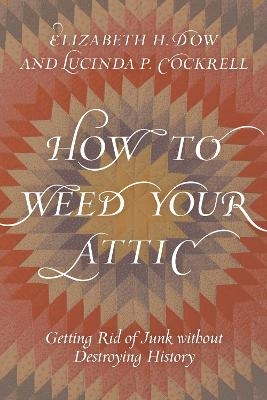
How to Weed Your Attic
Rowman & Littlefield (Verlag)
978-1-5381-1546-6 (ISBN)
How to Weed Your Attic: Getting Rid of Junk without Destroying History provides answers to the question: when someone dies or it’s time to move --- or just clean out the attic, garage, or basement, what papers and other things should we save for the sake of history and what can we safely toss?
After reading this clearly written book by a retired archivist and a retired museum curator, you can comfortably clean out your attic – or office, garage, basement, cupboards – with confidence that you’re not tossing out historically valuable (or invaluable) things, and that you will not ask your local museum to take things that really belong in a thrift store, junk yard, or recycle center.
The book first describes how to identify historically important documents and artifacts. The authors explain a few simple rules: 1) a complete or long collection has more value than a partial one; 2) emotive material provides a richer picture than factual material; 3) unique usually has more value than mass produced; 4) documents and objects carry more information than they intend to; and 5) a 25-year rule exists without our consciously recognizing it. They then apply the rules and assess the probable historical value of four different types of materials: mass produced (from books to vehicles), individually created (from art work to toys), business materials (from governance documents to uniforms), and commemorative materials (from awards to wedding dresses).
The book includes a brief description of the basics for preserving materials the reader wants to keep and references sources for more detail. It also recognizes that the reader may not want to keep stuff that clearly has historical value. For those readers, the authors describe how to donate materials to a cultural repository. In broad strokes, they explain how repositories differ, what the repository will want to know about the stuff you're offering, where an appraiser and/or tax advisor fits into the process, and what the reader can expect the repository to do and not do. Finally, the book addresses unexpected issues that may arise around questions of legal ownership and privacy. Throughout the book, the authors illustrate their points using photographs and vignettes.
Elizabeth H. Dow discovered during her last class toward a Ph.D. at the University of Pittsburgh's School of Library and Information Science, that she could blend her love of history and love of organizing information by becoming an archivist. Subsequently, she worked as an archivist at the Henry Sheldon Museum in Middlebury, Vt., the Vermont State Archives, and the Special Collections Division of the University of Vermont's Bailey/Howe library. In 2001, she left Vermont to create the archives track in Louisiana State University's School of Library and Information Science. She retired as the J. Franklin Bayhi Professor of Library and Information Science in 2014, and moved back home to Hardwick, Vt. She is the author of Creating EAD-Compatible Finding Guides on Paper (Scarecrow Press, 2005), Electronic Records in the Manuscript Repository (Scarecrow Press, 2009), and Archivists, Collectors, Dealers, and Replevin: Case Studies on Private Ownership of Public Documents (Scarecrow, 2012). Lucinda P. Cockrell has worked professionally for more than thirty years in the museum, archives, and public history field. She has degrees in Historic Preservation and Museum Education, and is a Certified Archivist. Her career has been graced by positions held at the James K. Polk Ancestral Home (Columbia, Tennessee), the Yorktown (Virginia) Victory Center, and the Center for Popular Music at Middle Tennessee State University. She now lives in the mountains of Vermont with her husband, Dale, her dog, Enkidu, and volunteers in local museums and libraries, serves on boards, collects ephemera, and helps friends weed their attics.
Acknowledgments
Preface
1Why the Things in Your Attic Matter to History
2 General Rules for Making Decisions
3Historical Value: Mass Produced Items
4Historical Value: Individualized Materials
5Historical Value: Corporate Records
6Historical Value: Commemorative Material
7Special Issues
8 Preserving Your Family Objects and Papers
9Donating Your Family Objects and Papers
Index
About the Authors
| Erscheinungsdatum | 12.09.2018 |
|---|---|
| Verlagsort | Lanham, MD |
| Sprache | englisch |
| Maße | 160 x 240 mm |
| Gewicht | 408 g |
| Themenwelt | Sachbuch/Ratgeber ► Freizeit / Hobby ► Hausbau / Einrichten / Renovieren |
| Sachbuch/Ratgeber ► Freizeit / Hobby ► Heimwerken / Do it yourself | |
| Sachbuch/Ratgeber ► Gesundheit / Leben / Psychologie ► Lebenshilfe / Lebensführung | |
| ISBN-10 | 1-5381-1546-8 / 1538115468 |
| ISBN-13 | 978-1-5381-1546-6 / 9781538115466 |
| Zustand | Neuware |
| Haben Sie eine Frage zum Produkt? |
aus dem Bereich


